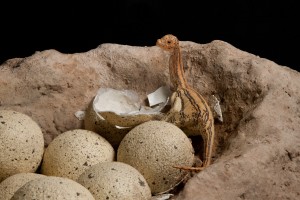
Last week, along with a group of other journalists, I got a sneak peek at The World’s Largest Dinosaurs, an exhibit that opened on April 16 at the American Museum of Natural History and will be open until January 2. This exhibit departs from the traditional dino-formula of towering skeletons by asking questions about the biology that supported the growth and maintenance of those massive bodies.
That’s not to say that there aren’t big dinosaurs. The model of the Mamenchiosaurus strains the room proportions, but the best part is her double-role as a screen for videos that describe how she breathed, the hundreds of liters of blood coursing through her body and 30-ft-long neck, and how she digested hundreds of pounds of food each day.
But though Mamenchiosaurus is daunting in size, she’s positively awe-inspiring once you get to the exhibit where you push a pump that simulates the heart that would pump her blood. I managed to keep her going for a few heartbeats, but I soon got a warning message: “The dino is dizzy.” I didn’t last much longer.

In a quick conversation with respiratory biologist, Dr. Steve Perry, I learned about their über-efficient lungs. Like birds, these dinosaurs likely had lungs with two chambers. As a result, they could absorb oxygen both as they inhaled and as they exhaled, boosting their ability to extract oxygen from the air to 35 percent from the 20 percent that we mere humans manage.
By making all kinds of connections to large animals that currently walk the Earth—elephants, giraffes, and even large egg-laying birds—it became a little easier to wrap my head around these large creatures roaming the Earth. It was fun to get some biology to add some meat to those bones.
More on the research that formed the basis for this exhibit in Science and in the New York Times.
Want to follow a dinosaur on Twitter? @Giant_Dino
Image credits: © AMNH/D. Finnin
